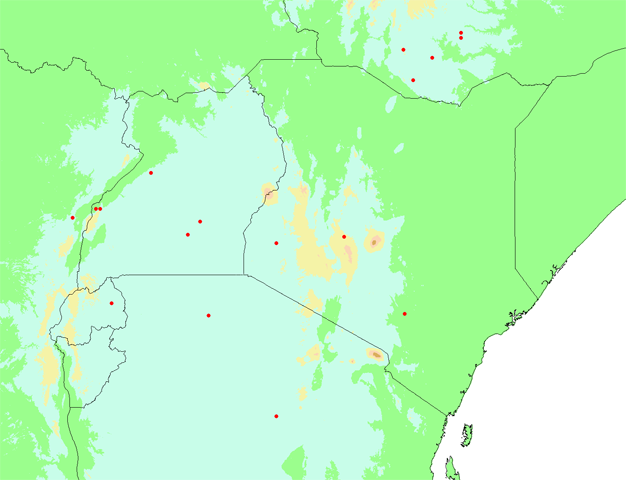Nomenclature
Ipomoea hildebrandtii Vatke in Linnaea. 43: 511 (1882); Bak. & Rendle in F.T.A. 4(2): 193 (1906); T.T.C.L.: 171 (1949); Verde. in Webbina 13:325 (1958). Type: Kenya, Teita, Buitchuma, Hildebrandt 2843 (B holo. Destroyed).
Ipomoea decora Vatke & Hildebr. in Monatschr. Ver. Gart. Preuss. Stat. 22: 139, t.2 (1879), non Meisn. (1869), nom. Illegit.
Rivea decora (Vatke & Hildebr.) Hall. F. in E.J. 18: 156 (1893).
Argyreia populifolia Choisy var. africana Oliv. in T.L.S. 29: 114 (1875).
Ipomoea populifolia sensu Hall. F in E.J. 28: 53 (1899) quoad Speke & Grant 627, non (Choisy) Hall. F.
Ipomoea gillei Staner in Ann. Soc. Sc. Brux. 58: 109 (1938).
Description
Demissew, S. 2006. Convolvulaceae. In: Hedberg, I., E. Kelbessa, S. Edwards, S. Demissew and E. Persson (eds.), Flora of Ethiopia and Eritrea, vol. 5, pp. 227–231. The National Herbarium Addis Ababa University and The Department of Systematic Botany Uppsala University; Addis Ababa, Ethiopia and Uppsala, Sweden.
Maquet, P., Convovulaceae. 1985. In: Troupin, G. (ed.), Flore du Rwanda, Spermatophytes, vol, 3, pp. 231–254. Agence de Cooperation Culturelle et Technique, Liège.
Verdcourt, B. 1963. Convolvulaceae. In: Hubbard, C.E. and E. Milne-Redhead (eds.), Flora of Tropical East Africa, pp. 144–145. Crown Agent for Overseas governments and administrations, London.
Verdcourt, B. 1962. Notes from the East Africa Herbarium: XIII. Kew Bulletin 15(3): 443–445.
Biogeography, Ecology and Natural History

Kenya, Tanzania, Uganda, Ethiopia, Democratic Republic of the Congo, Rwanda.
Open grassland with scattered trees or bushes and/or upland scrub; 400–1700 (–2000) m.
Number of collections seen: 11
|
months |
Jan |
Feb |
Mar |
Apr |
May |
Jun |
Jul |
Aug |
Sep |
Oct |
Nov |
Dec |
|
# flowering specimens |
2 |
2 |
1 |
2 |
2 |
2 |
||||||
|
# fruiting specimens |
1 |
1 |
Demissew, S. 2006. Convolvulaceae. In: Hedberg, I., E. Kelbessa, S. Edwards, S. Demissew and E. Persson (eds.), Flora of Ethiopia and Eritrea, vol. 5, pp. 227–231. The National Herbarium Addis Ababa University and The Department of Systematic Botany Uppsala University; Addis Ababa, Ethiopia and Uppsala, Sweden.
Maquet, P., Convovulaceae. 1985. In: Troupin, G. (ed.), Flore du Rwanda, Spermatophytes, vol, 3, pp. 231–254. Agence de Cooperation Culturelle et Technique, Liège.
Verdcourt, B. 1963. Convolvulaceae. In: Hubbard, C.E. and E. Milne-Redhead (eds.), Flora of Tropical East Africa, pp. 144–145. Crown Agent for Overseas governments and administrations, London.
Other information
Three subspecies are recognised with subsp. grantii spread in Uganda, Kenya,Tanzanya, Democratic Republic of the Congo and Rwanda; subsp. hildebrantii restricted to Kenya and Tanzania; and subsp. megaënsis restricted to Kenya and southern Ethiopia. The three are distinguished by the corolla length (4–8.5 cm in subsp. grantii (5.7–)7–11.5 cm in subsp. hildebrantii and 4–5.5 cm in subsp. megaënsis), the corolla colour (in the same order purple with pale or white limb; limb pale, white or purple; and all purple); the bracts and sepal indumentum type (pubescent; hairy or villous; and silky-tomentose to villous respectively); and the bracts and sepals length to breath ratio of ((2.25–)2.9–4.16, 1.63–2.8 and 2.4–3.12 respectively).
Authorship for webpage



Add new comment